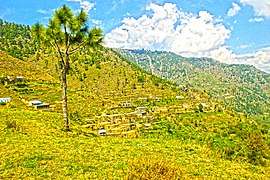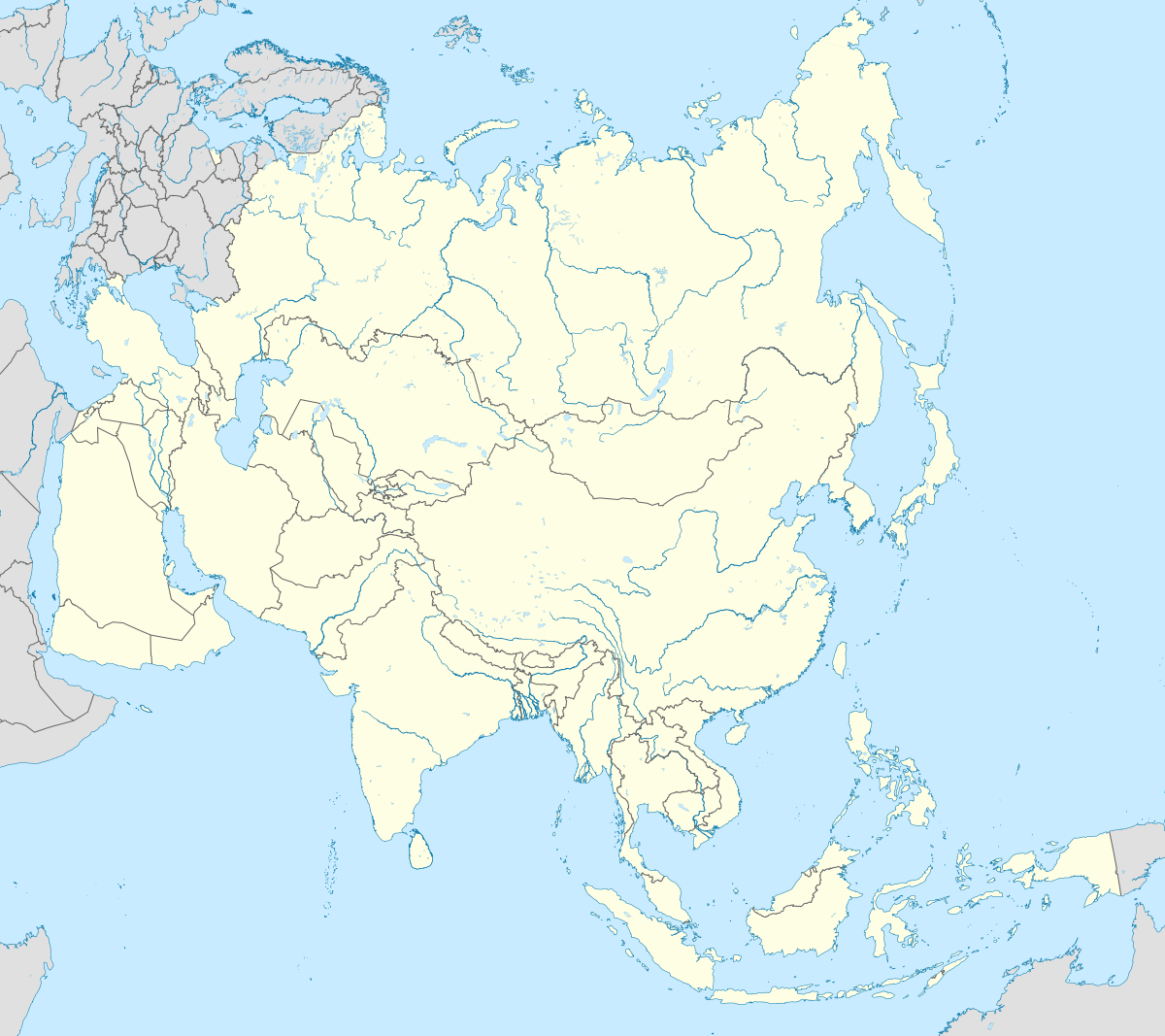Swabi
Swabi or Sawabai (Urdu صوابی) is a city in Khyber Pakhtunkhwa province of Pakistan.[2] It is located near the bank of the Indus River.[3] It is the 73rd largest city of Pakistan and eighth largest in the province of Khyber Pakhtunkhwa. Swabi is also a key city in Mardan Division, where it is the second-largest city.
Swabi صوابۍ | |
|---|---|
 | |
 Swabi  Swabi  Swabi .svg.png) Swabi | |
| Coordinates: 34°7′12.5580″N 72°28′12.5544″E | |
| Country | |
| Province | |
| District | Swabi |
| Tehsil | Swabi |
| Elevation | 340 m (1,120 ft) |
| Population | |
| • Total | 123,412 |
| • Rank | 73rd, Pakistan 8th, Khyber Pakhtunkhwa |
| Time zone | UTC+5 (PST) |
| Calling code | +92 938 |
Hindkowans were the original inhabitants of the region. They spoke an Indo-Aryan language called Hindko language.[4] The "Hindko" people were named by the later Pashtun migrants to the region, for the groups who spoke "the Indian language"; and for the Iranic Pashtuns to differenciate themselves from the Indo-Aryan speaking locals.[5]
Demographics
| Year | Pop. | ±% p.a. |
|---|---|---|
| 1961 | 17,542 | — |
| 1972 | 37,292 | +7.10% |
| 1981 | 46,344 | +2.44% |
| 1998 | 80,157 | +3.28% |
| 2017 | 123,412 | +2.30% |
| Source: [6] | ||
According to the 2017 Census of Pakistan, the city of Swabi had 123,412 inhabitants, making it the eighth-largest city in Khyber Pakhtunkhwa. These inhabitants were spread out among 16,212 households, making the average household size in Swabi 7.61. [1] Swabi experienced quick growth throughout the latter half of the twentieth century, as the population of Swabi grew nearly fivefold in just 40 years. The city's growth has, though, over time, slowed down, and between the years of 1998 and 2017, its population only grew at a rate of 2.29% every year.
Climate
Swabi has a warm and temperate climate. With hot, humid summers and mild winters, Swabi features a humid subtropical climate (Köppen Cwa). The average temperature in Swabi is 22.2 °C, while the annual precipitation averages 639 mm. November is the driest month with an average rainfall of 12 mm, while the wettest month is August, with an average 137 mm of precipitation.
June is the hottest month of the year with an average temperature of 32.9 °C. The coldest month January has an average temperature of 10.2 °C.
| Climate data for Swabi | |||||||||||||
|---|---|---|---|---|---|---|---|---|---|---|---|---|---|
| Month | Jan | Feb | Mar | Apr | May | Jun | Jul | Aug | Sep | Oct | Nov | Dec | Year |
| Average high °C (°F) | 17.7 (63.9) |
19.0 (66.2) |
24.0 (75.2) |
30.1 (86.2) |
36.3 (97.3) |
41.4 (106.5) |
38.5 (101.3) |
36.5 (97.7) |
35.3 (95.5) |
31.6 (88.9) |
25.1 (77.2) |
19.4 (66.9) |
29.6 (85.2) |
| Daily mean °C (°F) | 10.2 (50.4) |
12.7 (54.9) |
17.5 (63.5) |
22.7 (72.9) |
28.0 (82.4) |
32.9 (91.2) |
31.8 (89.2) |
30.4 (86.7) |
28.4 (83.1) |
23.4 (74.1) |
16.9 (62.4) |
11.7 (53.1) |
22.2 (72.0) |
| Average low °C (°F) | 2.3 (36.1) |
5.5 (41.9) |
10.4 (50.7) |
15.3 (59.5) |
20.2 (68.4) |
25.1 (77.2) |
26.2 (79.2) |
25.5 (77.9) |
22.3 (72.1) |
14.9 (58.8) |
7.4 (45.3) |
2.7 (36.9) |
14.8 (58.7) |
| Average precipitation mm (inches) | 55 (2.2) |
58 (2.3) |
69 (2.7) |
47 (1.9) |
23 (0.9) |
25 (1.0) |
110 (4.3) |
137 (5.4) |
58 (2.3) |
14 (0.6) |
12 (0.5) |
31 (1.2) |
639 (25.3) |
| Source: Climate-Data.org[7] | |||||||||||||
Education
Following are some of the notable educational institutes in Swabi:
See Also
- List of cities in Khyber Pakhtunkhwa by population
- Mardan Division
- Swabi District
- Swabi Tehsil
- Topi
- Tordher
- Zaida
References
- "POPULATION AND HOUSEHOLD DETAIL FROM BLOCK TO DISTRICT LEVEL KHYBER PAKHTUNKHWA (SWABI DISTRICT)" (PDF). SWABI_BLOCKWISE.pdf. Pakistan Bureau of Statistics. 3 January 2018. Archived from the original (PDF) on 23 June 2020. Retrieved 23 June 2020.
- Tehsils & Unions in the District of Swabi Archived 2012-02-09 at the Wayback Machine
- Location of Swabi - Falling Rain Genomics
- Qadeer, Mohammad A. (2006). Pakistan: Social and Cultural Transformations in a Muslim Nation. Taylor & Francis. p. 40. ISBN 978-0415375665.
- Shackle 1980, p. 482; Rensch 1992, pp. 3–4. See there for alternative etymologies.
- "TABLE-1: AREA & POPULATION OF ADMINISTRATIVE UNITS BY RURAL/URBAN: 1951-1998 CENSUSES" (PDF). Administrative Units.pdf. Pakistan Bureau of Statistics. Archived (PDF) from the original on 20 June 2020. Retrieved 20 June 2020.
- "Climate: Swabi - Climate-Data.org". Retrieved 18 March 2018.
- http://www.giki.edu.pk/
- http://www.uoswabi.edu.pk/ University of Swabi
- http://gkmcs.edu.pk/
- http://www.wus.edu.pk